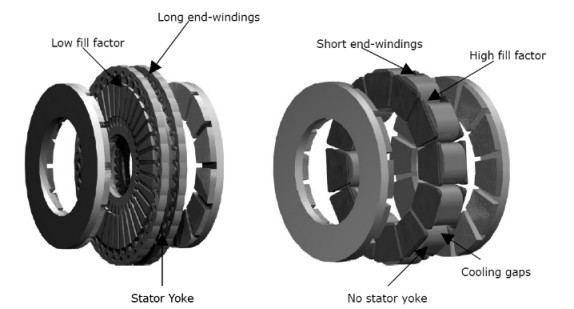| Issue 9 |
Oxford YASA Motors is a recent spin-out company from Oxford University. The company was founded in September 2009 to commercialise the Yokeless And Segmented Armature (YASA) motor, which has been shown to have an outstanding torque to weight ratio. The company has already achieved £200k of sales and has a strong order book.
In April 2005 I began my DPhil at the Oxford Engineering department and was presented with a daunting task: to design, build and test the electrical power train of the world's first hydrogen sports car. My DPhil (supervised by Dr Malcolm McCulloch) began with a search for high torque lightweight motors available off-the-shelf. Unfortunately, it quickly became clear that there was a problem: the motors were too heavy. Instead of meeting the budgeted 20 kg/motor, they typically weighed 50-120 kg, presenting a major problem since four were required. To make matters worse, it was shown during the LIghtweight Fuel Efficient Car (LIFECar) project that overweight subsystems had a compounding impact on the weight and efficiency of the vehicle (for example, a heavy motor require a larger fuel cell, more ultra-capacitors and a heavier chassis...) The challenge had been set: produce a new motor 2.5 times lighter than any existing off-the-shelf technology.
After a focused literature survey it become clear that axial-flux machines (the flux moves "axially" rather than radially through the machine) offered the potential for a high torque density; however, the machines weren't available off-the-shelf in 2005 due to manufacturing difficulties. The key advantage of the axial flux (or "pancake") machine can best be described by comparing its shape to that of a disc brake: large in diameter and axially very short. In comparison, a radial flux (or conventional) motor could be compared to a drum brake, which typically has a lower braking torque density. Despite the potential for weight reduction it was the manufacturing of the axial flux technology that had meant it had limited commercial success. The motor could not be made by stacking laminations (as in a conventional machine), but rather required the lamination to be wound in a spiral and then spark eroded. The axial flux machine suffered from a number of additional problems including poor cooling capability (key to high torque density), difficulties in controlling the axial airgaps and a complex winding.
Despite the challenges I began researching the axial flux motor in combination with new materials in the hope of finding a novel solution to these problems. It was in September 2005 when the breakthrough came: by segmenting the axial flux motor in discrete "pole-pieces" the motor could be manufactured easily using Soft Magnetic Composite (SMC) parts. SMC comes in a powdered form and can be pressed at low cost into a wide variety of 3-D shapes. This removed the need for the complex laminations, overcoming the major manufacturing challenge of the axial flux machine. It also dramatically simplified the winding and ultimately transformed the cooling capability of the machine. Some of these advantages are described in Figure 1.

|
| Figure 1: Left - typical axial flux machine; right - YASA machine1 |
My research suggested that this motor would achieve a torque density of 15 Nm/kg - up by 50% on the best available motors at the time. It also estimated that the cooling capability of the machine could be doubled, potentially further increasing the torque density. However, the motor was still too heavy to drive the LIFECar wheels directly so a bespoke gearbox was designed and integrated into the motor. The overall package weighed 20.0 kg - meeting project weight budget.
The technical advantages of the YASA motor were so significant that a commercial proposition was put forward by ISIS Innovation (the technology transfer company owned by Oxford University). This led to the creation of Oxford YASA Motors Ltd, with £1.5m being invested in the company in September 2009. Further development of the motor (including four patent applications which are currently pending) has led to the company's first product, which boasts a torque density of 28 Nm/kg (a 23 kg motor producing 650 Nm). The motor's torque density is now sufficiently high that a gearbox is no longer required, which makes the overall driveline simpler and more efficient, yet still lower in weight. Further improvements of the YASA motor mean that the company's second product (due to be ready in early 2011) will produce a stunning 1000 Nm in a 25 kg package - a torque density of 40 Nm/kg. This is typically 3-8 times higher than the best motors currently available off-the-shelf.
Although Oxford YASA Motors is a relatively young company, it now employs 10 people and the company will achieve sales of £1-2m in its first year and estimates a further £1.5m of sales in 2011. A number of demonstrator vehicles can be seen using the motors, such as the Delta E4 Cope or the Westfield iRacer (http://www.oxfordyasamotors.com/drifting-electric-car). The company also won a £1.9m project (http://www.yamog.co.uk/), funded by the Technology Strategy Board, which aims to achieve a price point of £1000/motor (10,000 off volume). Although Oxford YASA Motors is currently focused on automotive applications, it is expected that the motor would perform equally well in a range of applications, such as aerospace, renewables or the industrial markets where weight reduction, efficiency and cost benefits could also be achieved.
Electric motors have been around for over 100 years yet the success of the YASA motor is a pleasant reminder that innovation is always possible where creativity and academic freedom are encouraged. Dr McCulloch - who is now on his third spinout company - should be applauded for this.
| << Previous article | Contents | Next article >> |
| SOUE News Home |
Copyright © 2010 Society of Oxford University Engineers |
SOUE Home |